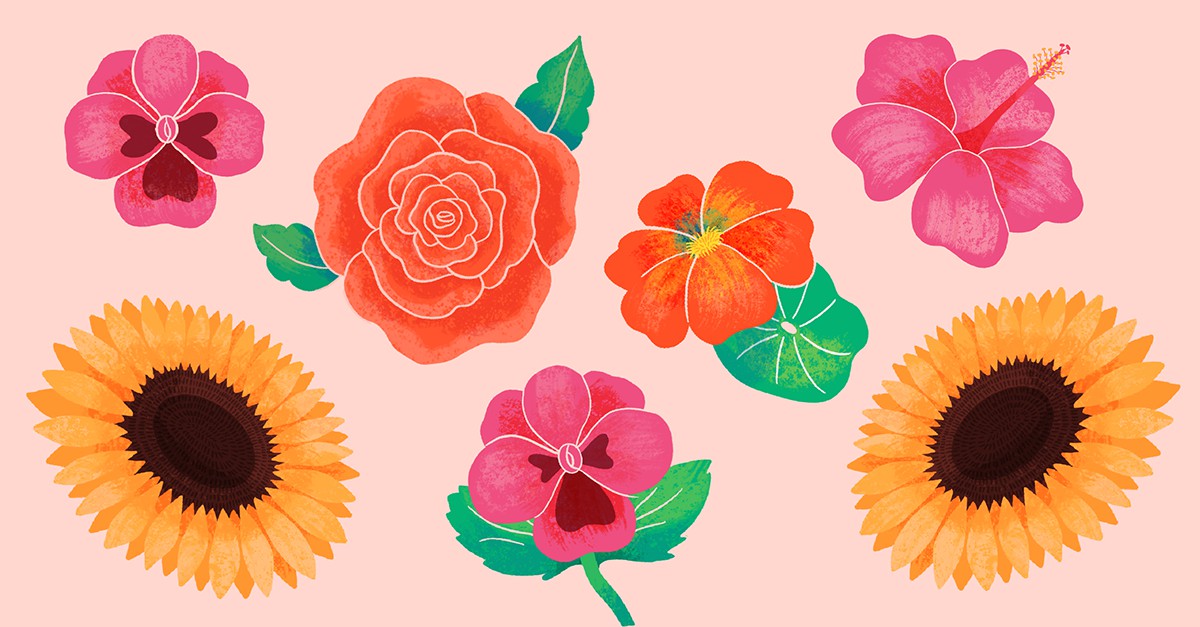Flowers aren’t just for pots and vases, but plates too! Curious chefs and home cooks have extended familiar menus to incorporate newer flavors like rose and lavender. And the floral food trend doesn’t stop at tasty tea and pastries. You can add many flowers from your garden to your plate not just as a colorful decoration, but as a key ingredient full of flavor and nutrition.
Keep reading to learn how to prepare edible flowers to spruce up foods and drinks, then discover edible flower options and their potential health benefits.
How to Prepare Edible Flowers
Flowers taste best plucked straight from the yard. Pick freshly bloomed blossoms in clean, pesticide-free areas away from roads and animals. Soak the blooms in water and gently shake to rinse. Remove everything except the petals, as other flower parts are usually either bitter or inedible sans a few exceptions. It’s best to eat flowers as soon as possible, although you may store them in the fridge in a container for a couple of days.
If you’re interested in purchasing edible flowers, buy them from the organic section of a grocery store, as flower shops and greenhouses often treat their supplies with pesticides.
Edible Flowers to Expand Your Palate
Before we dive into some floral food options, note that not all flowers are edible. Before yanking a random flower out of the dirt for your dinner, always conduct your research. Some species are toxic, and even edible flowers may have been exposed to pesticides. Meanwhile, even if a flower is edible and organic, you may be allergic to it, so stay in the lane of caution before digging in.
With that in mind, these flowers are usually safe to start with.
Pansies
Pansies come in different colors, and consequently, offer different nutritional content. A 2019 study reported that white and yellow had the highest protein content, while red had the highest carbohydrate content. Pansies also contain compounds with antioxidant and anti-inflammatory properties.
Meanwhile, a pansy’s mild flavor makes it a nice introduction to the delicious world of flowers. You can also munch on the entire flower instead of just the petals. Use pansies as an eye-catching garnish, or sprinkle them in a fresh, crunchy salad for a colorful health kick. If you’re in the mood for some sweets, you can even crystallize them to decorate a dessert!
Nasturtiums
Nasturtiums’ versatility makes them a popular addition to meals. Rich in vitamin C, nasturtium petals and leaves may strengthen the immune system and help you fight bacterial and fungal infections. They’re also a great source of iron, manganese, flavonoids, and beta carotene.
Their sunset-colored petals, reminiscent of the summer season when they bloom, can spice up a salad in terms of both visuals and taste. Behind an initial subtle sweetness, you’ll detect a peppery zest. The seeds make an excellent garnish with parsley. Mix the flowers with cream cheese or butter, tuck them in a sandwich, or add them to vinegar for a colorful, flavorful salad dressing.

Roses
Roses are as delicious as they are beloved. However, not many people know about their health benefits beyond a pleasing scent and beautiful look. Rose hips — located below the petals where the seeds are stored — are an excellent natural source of vitamin C, and people use them for relief from osteoarthritis and pain after surgery.
You can find a variety of roses, which means they don’t all taste the same. As a general tip, try to choose one that smells pleasant as an indicator of taste. The petals taste slightly sweet. After removing the bitter white petal base, you can consume them raw with salads, dried with granola or mixed herbs, infused in beverages and jams, or crystallized for dessert decoration. However, be aware that processing and drying the petals degrades the vitamin C.
Sunflowers
Known for their nutritious seeds — often salted, roasted, or glazed in honey — sunflowers’ petals and buds are also edible. One cup of seeds contains about 29 grams of protein, a large volume of essential amino acids, and various minerals. They can help lower cholesterol; supply vitamin E; promote brain, hair, and skin health; and much more. Crunch on the seeds whole, dry the petals for tea or scatter them across salads for a mild nutty flavor, and blanch the buds to toss in garlic butter for an artichoke-like flavor.
Hibiscuses
Hibiscuses have large, colorful blossoms that are usually red, yellow, pink, white, or multicolored. On top of decorative purposes, people use them for culinary flourishes. Although more research must be done to understand the full scope of the plant’s health benefits, some studies suggest hibiscus tea helps lower blood pressure, combat bacteria, and improve liver health.
They have a sour, tart flavor and you can consume them fresh or dried, hot or cold. The tartness and sourness levels can be gauged by their color, as lighter hibiscuses are more tart and sour, while darker hibiscuses are fuller and richer. Enjoy hibiscus petals in tea, jam, sugar, or relish — or as lively additions to a refreshing fruit salad.
Lilacs
Lilacs symbolize spring and renewal. They can also fill your plate with a delicate purple or white touch and a floral, slightly bitter taste that matches their aroma. Their petals contain lutein, which may help improve eye health, prevent macular degeneration, and decrease your risk of developing cataracts.
You can infuse lilacs to create lilac sugar, syrup, and honey, or use them as a floral ice cream base and garnish for other sweets like cake and pudding. In the mood for a bit more experimentation? Mix fresh lilac in cream cheese or yogurt for a lemony punch that’s as pleasantly surprising as the start of a new season.
Conclusion
Edible flowers are a sight to behold and a taste to remember. Mix and match them in your foods and drinks for a new, delicious experience that appeals to multiple senses — and also benefits your health!
